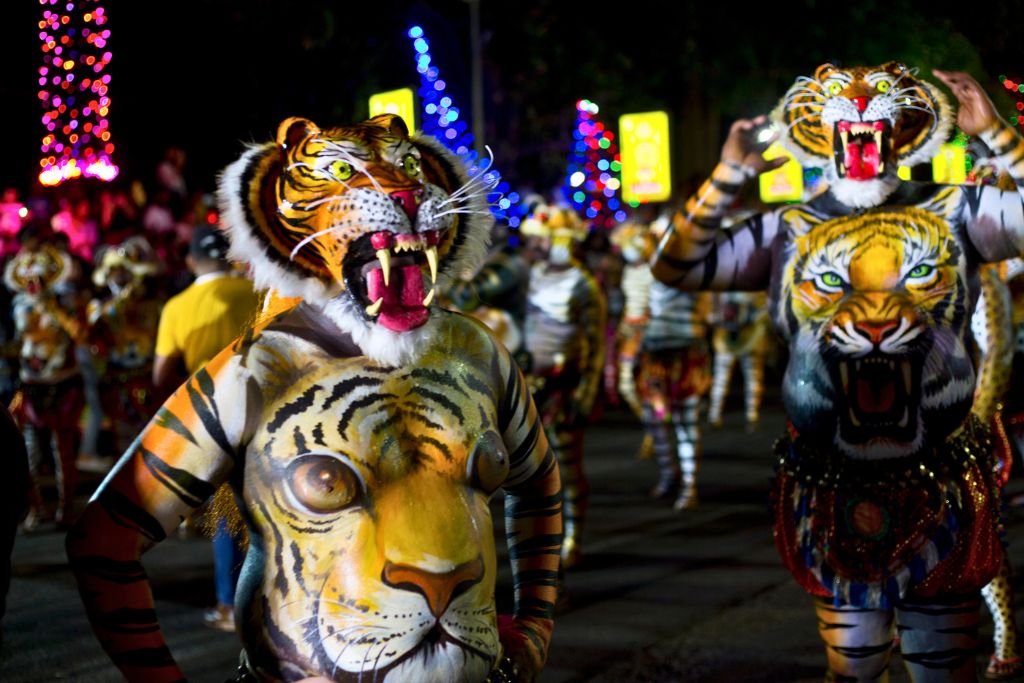
This is Pulikkali — Kerala’s roaring Onam dance
Thrissur's traditional Pulikkali street performance, part of the Onam festival, involves locals painting themselves as leopards, tigers and lions. The 200-year-old tradition is accompanied by percussion beats. The event is a big tourist attraction in the state.
In the Thrissur district of Kerala, Pulikkali dance is performed on the fourth day of Onam festival, with the local people painting themselves as leopards, tigers and lions and dancing to the rhythmic tune of traditional drums such as chenda and thakil. The tune used for Pulikkali Onam dance has a unique rhythm and is popularly known as pulimelam. It is believed that the tradition is around 200 years old. Each Pulikkali team comprises 50 dancers.
Also Read: Cham – the mask dance of monks
Pulikkali performers undergo elaborate body painting preparations. The process begins days in advance, and participants wear the paint for several hours, battling both the scorching heat and fatigue. While Pulikkali has been a male-centric performance for a long time, women have started participating in the event in recent years.
Also Read: Have you seen these traditional Indian dances yet?
Traditional drummers form a lively ensemble, playing the rhythmic pulimelam tune for the Pulikkali performers. Each Pulikkali team is accompanied by its own dedicated band.
Pulikkali, with its folk origins, reflects Kerala’s deep ties to its wildlife-rich environment. The state’s folklore and culture are intertwined with tales of the jungle and animals, making Pulikkali a symbol of the human-nature connection. Given Kerala’s rising human-animal conflicts, Pulikkali holds the potential to raise awareness about the peaceful coexistence of humans and wildlife.
Also Read: Traditional snake boat race in Kerala waters
Pulikkali performers are carefully chosen, with a significant criterion being a sizeable pot belly. This requirement allows for the creation of large panther paintings on their bellies. Given the fierce competition for the title of the best Pulikkali team, each team invests extensively in recruiting the most suitable candidates with impressive bellies.
Pulikkali has enjoyed long-term popularity in central Kerala, but in recent years, it has captured the attention of other regions within the state. On the day of the festival, merchandise like leopard masks sells in abundance, with many young participants painting themselves as leopards and tigers to join the cheering crowd.
Also Read: Theyyam – Narrating stories of gods
Pulikkali dancers adorn themselves with a chain of metallic bells around their waist. The rattling of these bells adds more rhythm to the performance.
Also Read: Holi moly: Here’s a look at Tharu tribe’s celebrations
Every Pulikkali team also carefully designs a theme-based tableau, which a panel of judges assesses for both artistic excellence and relevance. This year’s themes ranged from the Mahabharata and Egyptian culture to Theyyam, a Kerala folk dance, and the issue of human-animal conflict.
The state government is using Pulikkali as a platform to convey vital public awareness messages, including the significance of voting and cleanliness. Seen here is a prominent cut-out in Thrissur, encouraging the public to exercise their voting rights.
Pulikkali is an arduous physical performance, requiring participants to be on the streets for over seven hours. Following the performance, a panel of judges declares the winning team. Once the accolades and prizes are received, performers begin the strenuous process of removing the body paint. The paint is difficult to remove, and the local administration ensures each team receives sufficient kerosene to help in the removal of the enamel paint.
The Pulikkali tradition has in recent years seen a reduction in the number of performers due to the substantial increase in expenses required to assemble a professional team. Despite the support and funding from the local administration and both the Union and state governments to preserve this tradition, the desoms (teams belonging to separate villages) responsible for organising Pulikkali face annual financial challenges. While Thrissur once boasted over 15 Pulikkali teams, only five remain now.
The lead image at the top shows local enthusiast, with their face adorned in vibrant tiger-like paint, striking a captivating pose for the camera (Photo by Joyel K. Pious)
Text and photographs by Joyel K. Pious, a Kerala-based photographer, writer and editor.










